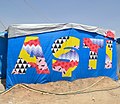Seb Toussaint | |
|---|---|
 Seb Toussaint in Rio de Janeiro, 2016 | |
| Born | 5 June 1988 |
| Nationality | British and French |
| Known for | Street art, Graffiti, Painting |
| Website | www |
Seb Toussaint is a Franco-British artist and muralist born in Caen in 1988. [1]
Contents
- Life and career
- Share the Word Project
- Project host countries
- PAZ in Colombia
- Exhibitions
- 2025
- 2020
- 2019
- 2018
- 2017
- Notes
- External links
Coming from the ultra scene, [2] he is mainly known for his street-art project Share the Word.
As part of this project, he has produced more than 200 murals representing words proposed by inhabitants of different countries. [3] These words also serve as the basis for his work on canvas.










